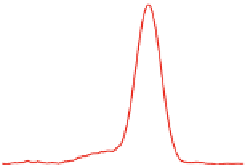Biomedical Engineering Reference
In-Depth Information
−
40
1
1. Calf
2. Tuna
3. Sole
5
4
3
−
30
4. Dogfish
5. Portuguese dogfish
6
2
6. Ling
−
20
−
10
0
05
10
15
20
25
30
35
40
45
Temperature (
°
C)
Denaturation temperatures of soluble collagen rods measured by optical rotation in dilute
acidic solution. Adapted from Joly-Duhamel et al.(
2002b
) © 2002 American Chemical
Society.
Figure 7.2
which they are derived. The relation between denaturation temperature and imino acid
content has been established for vertebrate and invertebrate species, and is connected
with the mechanism of stabilization of triple helices via the proportion of pyrrolidine
residues (Harrington and Rao,
1967
). This is shown in
Figure 7.2
, where the melting
peaks or denaturation temperatures were measured by optical rotation (OR) techniques
for soluble tropocollagen rods extracted under conditions which preserve their native
structure. Deep-water (cold-water)
fish such as cod have thermal denaturation temper-
atures around 15°C while those for surface-water (warm-water)
sh
-
from rivers and
lakes, and also including tuna
29°C). Warm-blooded land
animals (mammals) have a constant and large amount of Pro +Hyp and a denaturation
temperature around 36°C.
It is generally believed that the imino acid content affects the entropy of the
-
are much more stable (28
-
'
melting
'
or denaturation transition: the presence of pyrrolidine rings decreases the con
gurational
entropy of the random coil. If it is assumed that these rings undergo no conformational
change at the coil
helix transition, the melting temperature (denaturation) is then related
to the pyrrolidine content by
-
D
H
T
m
¼
S
;
ð
7
:
1
Þ
ð
1
-
p
i
ÞD
where p
i
is the fraction of imino acids. In this simpli
ed model, the enthalpic term is
constant, while in a more re
ned analysis the enthalpic term per residue should decrease
with the pyrrolidine content (Harrington and Rao,
1967
). Good qualitative agreement is
found with the
first assumption, but a more quantitative estimate of T
m
is obtained with
the more re
ned analysis.



































Search WWH ::

Custom Search